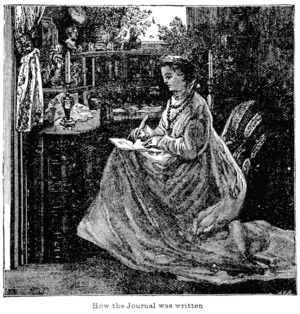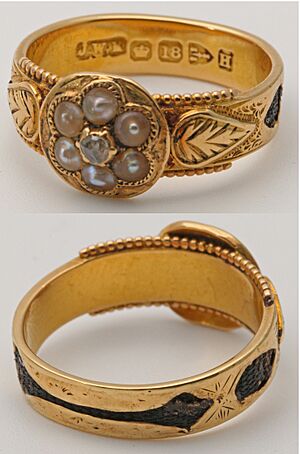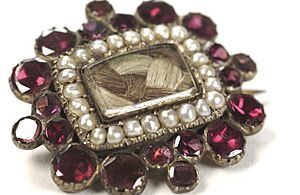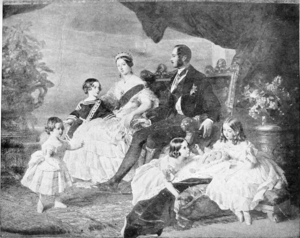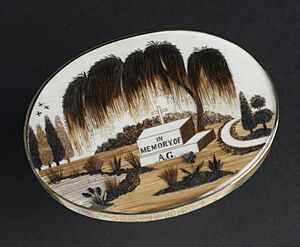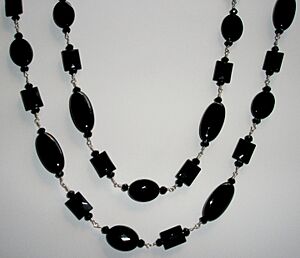Victorian jewellery facts for kids
Victorian jewellery was made in England when Queen Victoria was in charge, from 1837 to 1901. Queen Victoria was a very important person who set many trends for jewellery during her time. The amount of jewellery a person owned showed who they were and how important they were in society. During the Victorian era, jewellery had many different styles. These styles can be put into three main time periods: The Romantic period, the Grand period, and the Aesthetic period.
Contents
Jewellery and Social Status
Jewellery was very important in Victorian culture for showing a person's identity and social status. People in the Western world have always loved jewels because they are beautiful and highly wanted. Jewels were popular because they showed respect, high social class, and wealth, and they followed the latest trends.
Jewellery was also seen as a product that helped the economy grow. Wearing jewellery could show how important you were in society. Buying different kinds of jewels was a big trend that showed how rich you were and your social class. People from lower classes usually could not afford to keep up with this fashion. If a woman did not wear jewellery, it was often thought that she was too poor because she was from the working class.
Because so many people wanted certain jewels, factories started making them very quickly. Cheaper copies of these jewels were made, which meant middle class people could also afford them. During the Victorian era, women mostly wore jewels. It was not common for men to wear jewels because they were seen as something for women. Women who wore jewels were considered beautiful. Even though men did not wear jewels, they often gave them as gifts to women they liked.
Different Styles of Victorian Jewellery
Jewellery from the Victorian era is still famous for its unique designs. The way jewellery was made during this time was special because new machines and ideas were used. Machines helped make jewellery much faster and replaced work that people used to do by hand. The jewellery made during the Victorian era was very varied. Because of this, Victorian jewellery is split into three main periods: The Romantic period, the Grand period, and the Aesthetic Period. Each period has its own special features, including different inspirations, materials, and popular types of jewellery.
The Romantic Period (1837-1861)
The first period of Victorian jewellery is called the Romantic period, or early Victorian period. During this time, designers got ideas from the Renaissance, the Middle Ages, and nature. This period saw more use of gold in making jewellery.
Key features of this period included:
- Themes: Nature-inspired designs like snakes, lotus flowers, trees, and birds.
- Materials: Common materials were gold, small pearls, ivory, tortoiseshell, coral, onyx, agate, diamonds, amber, amethyst, emerald, and quartz.
- Common jewellery: Rings, brooches, bracelets, and cameos.
The Grand Period (1861-1885)
The second period of Victorian jewellery is known as the Grand period, or mid-Victorian period. Designs changed a lot in this period, from delicate to bold. This change matched the new roles and ideas about women at the time. During this period, copies of expensive jewellery became popular, and costume jewellery (fashion jewellery that looks expensive but isn't) first appeared. This was also a time when women started getting involved in business and politics. They also wanted to study at university, have the right to vote, and earn their own money.
Key features of this period included:
- Themes: Insects like flies, butterflies, dragonflies, and beetles.
- Materials: Gold was used to create a 'soft' look, along with clear stones, silver, jet, ivory, and pearls.
- Common jewellery: Earrings, brooches, bracelets, necklaces for evening events, and lockets for daily wear.
The death of Queen Victoria’s husband, Prince Albert, in 1861, also led to the popularity of mourning jewellery during this period.
The Aesthetic Period (1885-1901)
The third period of Victorian jewellery is called the Aesthetic period, or late Victorian period. During this time, there was a clear change in how women wore jewellery. This period encouraged women to have more power in society, as they started their own political organisations. This change led to more freedom of thought and less desire to always look very feminine. Because of this, women bought much less jewellery. They only chose to wear jewellery for special events, and very little jewellery was worn casually during the day.
Key features of this period included:
- Themes: A return to romantic styles, such as soft and natural colours, butterflies, and roses.
- Materials: Amethysts, emeralds, and opals.
- Common jewellery: Small and simple brooches, earrings, and bracelets almost disappeared.
During this era, Queen Victoria also continued to inspire the wearing of mourning jewellery.
Hair Jewellery
Hair jewellery became a popular fashion in the mid-1700s. It became even more common in the 1850s and stayed popular until the 1880s. Even though hair jewellery existed before 1861, its use by Queen Victoria after her husband Prince Albert died made it much more popular.
Using hair in jewellery for mourning was part of a Victorian tradition of keeping special objects. Putting strands of hair into jewellery was a way to make the mourning process feel more real. Hair was used as a keepsake because it was the only part of the body that did not change or decay after death. The idea of hair jewellery came from the need to feel a connection with someone who had passed away, even after they were gone.
Hair was a useful material that was put into many types of jewellery. Hair was often woven into bracelets, earrings, brooches, rings, and watch chains. Materials like pearls, gold, gems, and enamels were often added to hair jewellery as decoration. One common use for hair jewellery was to remember someone who had died. Another use was to honor the dead during funeral ceremonies. At funerals, women were allowed to wear special hair ornaments. These ornaments often had designs of skeletons, coffins, angels, and crossbones. Braided hair was also used in the flower arrangements at funerals.
Besides being a romantic keepsake and used at funerals, hair jewellery was also a popular fashion accessory. Not everyone could wear hair jewellery; it was mostly for middle class and upper class women. Hair jewellery was seen as a way to show a woman’s femininity and status in society.
Making hair jewellery was a common craft for women, and it showed their femininity. A woman's ability to make handicrafts like hair jewellery showed she was an ideal homemaker. Women who successfully made hair jewellery showed their skills at home and their womanhood in society. The skill of making jewellery from woven hair was often passed down from mothers to daughters. The high demand for making hair jewellery meant women wanted to be busy from their own homes. Hair jewellery was often made at home using tools like curling irons, tweezers, gum, a porcelain pallet, and a knife. More women started making their own hair jewellery because they did not trust jewellers. Sending hair from a loved one to a jeweller was seen as risky because there was no guarantee that the hair in the jewellery would actually belong to their loved one. Because of this, women began to craft their own hair jewellery.
Besides its main use for mourning, hair jewellery also had another use. It was exchanged as sentimental jewellery using hair from living people to show friendship.
Hair jewellery linked to Queen Victoria is very valuable today, with some pieces selling for a lot of money at auctions.
Mourning Jewellery
The process of mourning (grieving for someone who died) was long-lasting and done by both men and women. During this time, mourning jewellery was mostly worn by women. The idea of women wearing jewellery during their mourning period was linked to womanhood and how women had to keep their status strong to represent their husband, even while very sad.
After Queen Victoria’s husband, Prince Albert, died, Queen Victoria went into a period of mourning. This mourning period lasted for more than 40 years until Queen Victoria herself died. Many people grieved during Prince Albert's mourning. Queen Victoria made the royal court follow a strict mourning period. During this time, only jet jewels were allowed to be worn. The practice of wearing black mourning jewellery continued even after Prince Albert's mourning period because many babies died in England at that time.
After a loved one died, there was a ritual for those who were grieving. This ritual started from the day the person died and lasted for at least one year. During this time, grieving people were not allowed to wear shiny or reflective materials. They had to dress completely in black, including their clothes and jewellery. In the second year of mourning, however, grieving people were allowed to wear softer colours like white or clear materials, pearls, and diamonds.
Wearing mourning jewellery showed the strong bond between a living person and the deceased person. Because of this, the Victorian mourning period saw the creation of personalized jewellery used as keepsakes. Mourning jewellery often had the initials or names of the person who died and their date of death engraved into it to remember them. For example, a mourning ring for the writer Charlotte Brontë was found in 2019. It had her name and death date (March 1855) carved into it, and it held a braid of her hair behind a hidden panel.
The symbol of eyes was very important in mourning jewellery. A single eye was often put into jewellery like brooches. An eye meant that the spirit of the person who died was watching over the person wearing the jewellery. Another common element in jewellery was pearls, which stood for tear drops. The fashion of mourning jewellery slowly faded away in 1901 after the death of Queen Victoria.
During the mourning period, two main materials became very popular for jewellery. To meet the high demand for these materials, cheaper copies were made. Some of these copies included hardened rubber, also known as “french jet,” black enamel, and black glass. The two main materials used to make mourning jewellery were jet and black onyx jewels.
Jet Jewels
In the mid-1800s, jet was a very popular material because it was used in mourning jewellery. Because so many people wanted jet, a large industry was set up in Whitby (England). Jet, which is a fossilized material, was valued because it was light, very black, strong, cheap, and easy to carve. Jet was used to design mourning jewellery like bracelets, necklaces, brooches, cameos, and pendants. After Prince Albert died, Queen Victoria’s love for fancy jewellery was less obvious. The Queen mostly wore jet jewels, hair jewellery with the prince’s hair, and her wedding ring.
Black Onyx Jewels
Black onyx, also known as black-dyed chalcedony, was also commonly used to make mourning jewellery. It was mostly used for making cameos and in beadwork.
|


